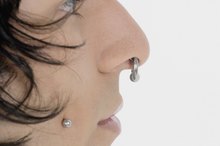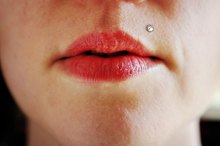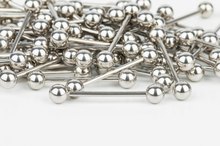Navel piercings, also known as belly rings, have become increasingly common in the last several decades 1. Those who choose to remove their navel jewelry may find that they have an unsightly scar, particularly if the piercing was traumatized in some way. Keloid or hypertrophic scars are common complications of navel piercings that did not heal properly or that suffered an injury such as being pulled or torn.
Navel Piercing Procedure
A navel piercing is performed with a hollow, single-use needle, called a cannula needle. After cleaning the navel with iodine or surgical scrub, the piercer marks a dot above and below the lip of the navel and uses a pair of clamps called Pennington forceps to line up the two dots. The needle goes through the bottom dot first and exits through the top dot. The piercer pushes in the appropriate jewelry, usually a 12- or 14-gauge curved barbell, while pushing the needle out. Navels can take up to six months to heal completely.
- A navel piercing is performed with a hollow, single-use needle, called a cannula needle.
- The piercer pushes in the appropriate jewelry, usually a 12- or 14-gauge curved barbell, while pushing the needle out.
Hypertrophic Scarring
How to Get Rid of Scars From Belly Piercings
Learn More
Hypertrophic scarring is a common complication of body piercing and usually results from trauma to the healing tissue. This trauma may be a tear suffered while playing sports or changing clothes or an infection resulting from improper aftercare. Excessive motion can also cause trauma, increasing the risk of navel piercing scars in those who are athletic or otherwise very active. While a hypertrophic scar is confined to the injured area and may improve over time, there is a chance that it will always remain.
- Hypertrophic scarring is a common complication of body piercing and usually results from trauma to the healing tissue.
- Excessive motion can also cause trauma, increasing the risk of navel piercing scars in those who are athletic or otherwise very active.
Navel Aftercare
The best way to prevent scarring in the first place is to follow the piercer's aftercare instructions meticulously. The Association of Professional Piercers recommends soaking the piercing once or twice a day in a warm saline solution and washing it immediately afterward with antibacterial or antimicrobial soap. Keeping hands away from the piercing while it heals reduces the risk of bacteria transmission that can lead to infection. Wearing loose-fitting clothing over a new navel piercing helps prevent the risk of snagging and tearing the tissue.
- The best way to prevent scarring in the first place is to follow the piercer's aftercare instructions meticulously.
- Wearing loose-fitting clothing over a new navel piercing helps prevent the risk of snagging and tearing the tissue.
Topical Scar Treatment
How to Get Rid of Hypertrophic Scars From Piercings
Learn More
Over-the-counter scar treatments are widely available 1. Containing such ingredients as silicone, vitamin E and onion extract, these creams can reduce the redness of scars if used consistently. Massaging the scar can help break down and redistribute collagen fibers, minimizing raised areas and discoloration. However, because a body piercing creates a tunnel of skin, or fistula, the hole itself may always be visible. The degree to which the hole is noticeable depends on such factors as how the piercing was cared for when it was healing and how long jewelry was worn.
- Over-the-counter scar treatments are widely available 1.
- Massaging the scar can help break down and redistribute collagen fibers, minimizing raised areas and discoloration.
Plastic Surgery for Fistulas
A qualified dermatologist or plastic surgeon can remove a fistula with a scalpel or dermal punch and suture the skin closed. According to the Victorian Cosmetic Institute, combining fistula excision with corticosteroid injections can help to flatten and diminish the appearance of the scar. Another option is cryotherapy, in which liquid nitrogen is applied directly to the scar to minimize it. Pulsed dye lasers and laser resurfacing can remove the redness from a navel piercing scar.
- A qualified dermatologist or plastic surgeon can remove a fistula with a scalpel or dermal punch and suture the skin closed.
- According to the Victorian Cosmetic Institute, combining fistula excision with corticosteroid injections can help to flatten and diminish the appearance of the scar.
Related Articles
References
- Kare Plastic Surgery: Belly Button Repair
- National Conference of State Legislatures. Tattooing and body piercing | state laws, statutes and regulations. March 13, 2019.
- Koenig, L. M., & Carnes, M. (1999). Body Piercing: Medical Concerns with Cutting-Edge Fashion. Journal of General Internal Medicine, 14(6), 379–385.
- Palo Alto Medical Foundation, Body Piercing
- National Conference of State Legislatures. Tattooing and body piercing | state laws, statutes and regulations. March 13, 2019.
- American Academy of Pediatrics. HealthyChildren.org. Body piercings, teens & potential health risks: AAP report explained. Updated September 18, 2017.
- Johns Hopkins All Children’s Hospital. Adolescent tattoos, body piercings and body modifications. November 21, 2017.
- Koenig, L. M., & Carnes, M. (1999). Body Piercing: Medical Concerns with Cutting-Edge Fashion. Journal of General Internal Medicine, 14(6), 379–385.
- Palo Alto Medical Foundation, Body Piercing
Writer Bio
Ann Jones has been writing since 1998. Her short stories have been published in several anthologies. Her journalistic work can be found in major magazines and newspapers. She has a Master of Fine Arts in creative writing.









